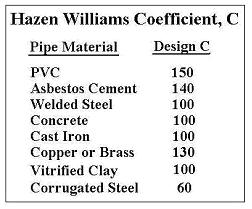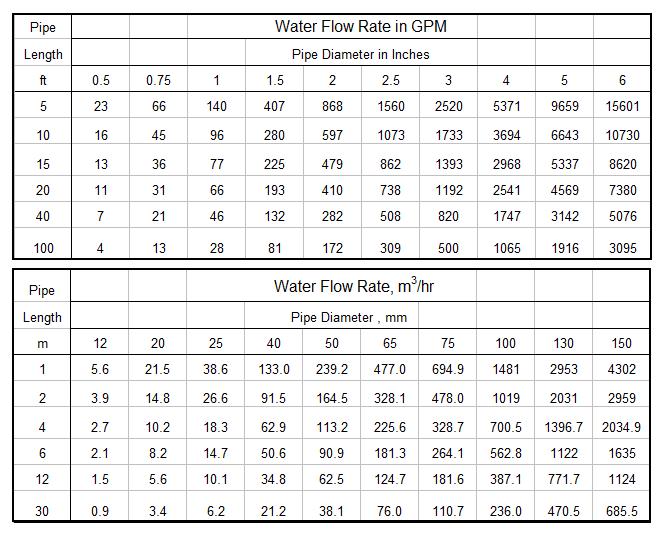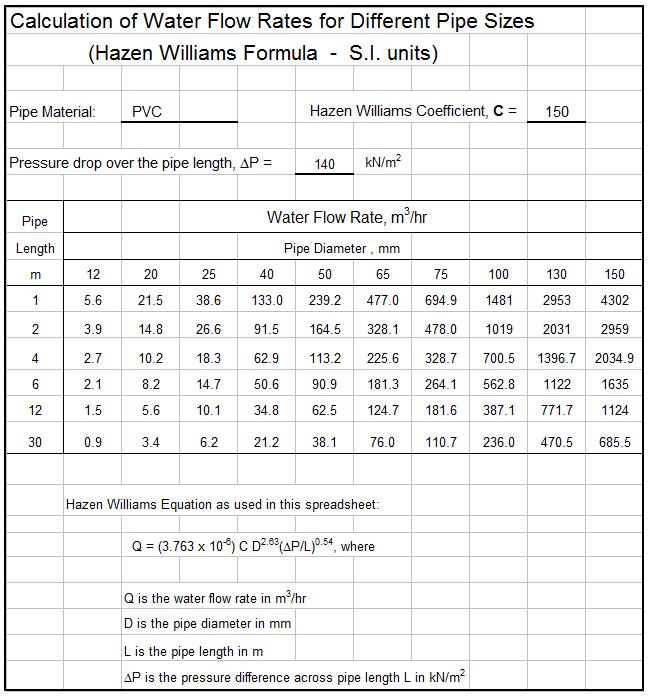Where to Find Excel Spreadsheets to Calculate Water Flow Rate for Pipe Sizes
For Excel spreadsheets to calculate water flow rate for pipe sizes using the Hazen Williams equation, click here to visit our spreadsheet store. Read on for information about the Hazen Williams equation and its use to calculate water flow rate for pipe sizes.
Excel spreadsheets are very convenient to calculate water flow rate for pipe sizes with the Hazen Williams equation. Both U.S. and S.I. units will be used in the Hazen Williams spreadsheets and calculations discussed in this article.
Hazen Williams Equation Limitations
The Hazen Williams equation is intended for turbulent water flow rate in pipes at normal ambient temperatures. The turbulent flow requirement isn’t normally a problem, because most practical transport of water in pipes is turbulent flow. The Hazen Williams formula works best for water temperature that isn’t too far above or below 60oF. For calculation of flow rates for pipes with a fluid other than water or for water at a temperature that is far above or far below 60oF, the Darcy Weisbach equation is an alternative to the Hazen Williams equation. For more information about this alternative, see the post, “Friction Factor/Pipe Flow Calculations with Excel Spreadsheets.”
Forms of the Hazen Williams Equation for Water Flow Rate for Pipe Sizes
The Hazen Williams equation is sometimes expressed as an equation for velocity in the pipe and sometimes as an equation for pipe flow rate. It also can be expressed in terms of the pipe head loss or the frictional pressure drop. Finally, the Hazen Williams equation can be written for U.S. or S.I. units.
As an equation for Velocity, the traditional form of the Hazen Williams equation is:
in U.S. units: V = 1.318 C R0.633S0.54, where:
- V is the water flow velocity, ft/sec
- C is the Hazen Williams coefficient, dimensionless (depends on pipe material and age)
- R is the hydraulic radius, ft (R = cross-sectional area of flow/wetted perimeter)
- S is the slope of the energy grade line, dimensionless (S = head loss/pipe length = hL/L)
in S.I. units:V = 0.85 C R0.633S0.54, where the parameters are as defined above with V in m/s and R in meters.
As an equation for water flow rate for pipe that is circular, the hydraulic radius is R = A/P = (πD2/4)/(πD) = D/4 and Q = VA = V(πD2/4). Substituting these equations into those for velocity give the following for the Hazen Williams equation:
in U.S. units: Q = 193.7 C D2.63S0.54, where:
- Q is the water flow rate in the pipe, gal/min (gpm)
- D is the pipe diameter, ft
- C and S are the same as defined above
in S.I. units: Q = 0.278 C D2.63S0.54, where the parameters are as defined above with Q in m3/s and D in meters.
In terms of frictional pressure drop, ΔP instead of frictional head loss, hL, the Hazen Williams equation is:
in U.S. units: Q = 0.442 C D2.63(ΔP/L)0.54, where
- Q is the water flow rate in the pipe, gpm,
- D is the pipe diameter, inches
- L is the pipe length, ft
- ΔP is the pressure difference across pipe length L, psi
In S.I. units: Q = (3.763 x 10-6) C D2.63(ΔP/L)0.54, where
- Q is the water flow rate in the pipe, m3/hr,
- D is the pipe diameter, mm
- L is the pipe length, m
- ΔP is the pressure difference across pipe length L, kN/m2
The Hazen Williams Coefficient – C – to Calculate Water Flow Rate for Pipe Sizes
 The Hazen Williams equation can be used to calculate water flow rates for pipe sizes, only if values of the Hazen Williams coefficient, C, can be obtained for the pipe materials in use. Values of C can be found on internet sites and in handbooks & textbooks. The table at the left shows C values for some commonly used pipe materials.
The Hazen Williams equation can be used to calculate water flow rates for pipe sizes, only if values of the Hazen Williams coefficient, C, can be obtained for the pipe materials in use. Values of C can be found on internet sites and in handbooks & textbooks. The table at the left shows C values for some commonly used pipe materials.
Source: Toro Ag Irrigation
A Table of Values of Water Flow Rate for Pipe Sizes and Lengths
The tables below were prepared using the equations: Q = 0.442 C D2.63(ΔP/L)0.54(U.S.) and Q = 0.278 C D2.63(ΔP/L)0.54(S.I.) with units as given above, to calculate the water flow rates for PVC pipe with diameters from 1/2 inch to 6 inches (1 mm to 30 mm) and length from 5 ft to 100 ft (12 m to 150 m), all for a pressure difference of 20 psi (140 kn/m2) across the particular length of pipe. The Hazen Williams coefficient was taken to be 150 per the table in the previous section.
Excel Spreadsheets to Calculate Water Flow Rate for Pipe Sizes
The table shown above can be calculated with an Excel spreadsheet like the one shown below. It has Excel formulas entered to calculate water flow rates for different pipe sizes using the Hazen Williams equation. This spreadsheet allows for entering the Hazen Williams coefficient for the proper pipe material, the pressure drop, and the pipe diameter(s) and length(s) of interest. The Excel formulas then calculate water flow rates for the entered pipe sizes and lengths. The spreadsheet shown below uses S.I. units. This spreadsheet and a similar one using U.S. units is available from our spreadsheet store. Those spreadsheets are also set up to calculate pipe diameter, length, or pressure drop if the other parameters are known.


